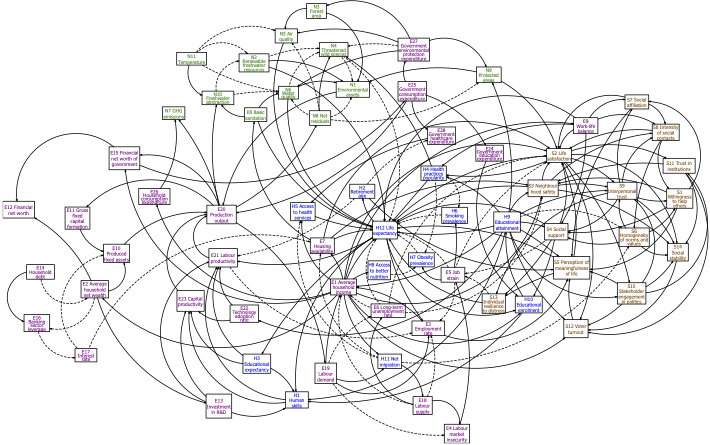
Well-being, happiness, quality of life or life satisfaction are the ultimate goals of any human, regardless of status, profession, wealth, religion, or nationality. Governments begin to focus their attention directly on the multidimensional national well-being, including and going beyond economic and material aspects. They look for new under-utilized resources that would raise the national well-being even despite weak economic growth. To discover effective and efficient solutions, one needs to maximize synergies and reduce losses from trade-offs. Systems analysis offers tools to do so.
Measuring well-being has become a major theme in public policy and governance recently, as researchers and policymakers attempt to unpack what exactly constitutes a "good life". Several projects such as the OECD’s Better Life Initiative have improved our ability to systematically assess the otherwise vague concept of well-being, to compare between different countries and to assess the distribution of well-being outcomes across the population. However, such well-being measures give us only part of the picture.
In filling this gap, IIASA researchers and their partners develop a comprehensive model that describes the full set of national systems that are key for producing and sustaining well-being at large. In 2018-2019 IIASA developed a pilot version of a systems description of the national well-being system (NWS) that is based on the OECD Well-being Framework and covers four major subsystems: economic subsystem, natural subsystem, human capacity subsystem, and social subsystem, each described by a set of indicators. This systems map allows tracing indirect effects and feedback loops between factors systematically, thus helping acquire a holistic understanding about the national well-being system. Therefore, such a systems map can assist policymakers to reveal trade-offs and synergies, reduce the problem’s “wickedness” and discipline a dialogue. For example, it can be used to identify the actors responsible for improvement of certain aspects of national well-being.
Based on this systems map, in 2020-2021, a study was conducted aiming at assessing impacts of various non-pharmaceutical interventions (NPIs) aiming at curbing the spread of the COVID-19 pandemic on the national well-being system. Since empirical evidence clearly indicates that systems thinking is difficult to practice when causal interconnections become more complex, especially when it involves indirect effects and feedback loops, formal methods are used to assess the cumulative (direct and indirect) impacts of NPIs on various national well-being components.
 © IIASA
© IIASA
National well-being systems map 1.0
Publications
Ilmola-Sheppard, L., Strelkovskii, N. , Rovenskaya, E. , Abramzon, S., & Bar, R. (2020). A systems description of the national well-being system. Version 1.0. IIASA Working Paper. Laxenburg, Austria: WP-20-003
Eker, S. & Ilmola-Sheppard, L. (2020). Systems Thinking to Understand National Well-Being from a Human Capital Perspective. Sustainability 12 (5) e1931. 10.3390/su12051931.
Immervol, H., MacDonald, D., Rovenskaya, E. , & Ilmola, L. (2020). Long-term Strategies for Employment and Well-being in the Digital Age. In: Systemic Thinking for Policy Making: The Potential of Systems Analysis for Addressing Global Policy Challenges in the 21st Century. pp. 99-112 Paris, France: New Approaches to Economic Challenges, OECD Publishing. ISBN 978-92-64-49456-5 10.1787/879c4f7a-en.
Feitelson, E., Ilmola-Sheppard, L., Rovenskaya, E. , Strelkovskii, N. , & Rein-Sapir, Y. (2020). The Impact of COVID-19 on Well-Being: A Systems Approach. IIASA Working Paper. Laxenburg, Austria: WP-20-019
Bartmann, R., Strelkovskii, N. , & Rovenskaya, E. (2020). A systems description of the national well-being system. Version 2.0: attaching data sources and identifying leverage points and responsible institutions. IIASA Working Paper. Laxenburg, Austria: WP-20-018
Strelkovskii, N. , Rovenskaya, E. , Ilmola-Sheppard, L., Bartmann, R., Rein-Sapir, Y., & Feitelson, E. (2022). Implications of COVID-19 Mitigation Policies for National Well-Being: A Systems Perspective. Sustainability 14 (1) p. 433. 10.3390/su14010433.
Strelkovskii, N. , Rovenskaya, E. , Ilmola-Sheppard, L., Bartmann, R., & Feitelson, E. (2022). A systems view on national well-being and implications of COVID-19 on it. In: WELL-BEING 2022 conference: Knowledge for Informed Decisions, 1-4 June, 2022, Luxembourg.



